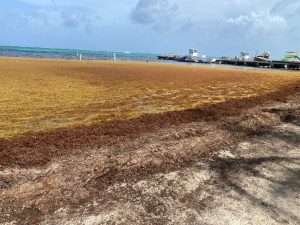Sargassum Crisis Hits San Pedro
As sargassum continues to wash ashore in San Pedro, the Town Council has adopted a direct, boots-on-the-ground strategy to manage the annual influx of the invasive seaweed. With heavy machinery proving too costly and often inefficient, this year’s focus is on swift manual removal, shovels, wheelbarrows, and all.
The unsightly brown algae, which blankets the beaches and emits a foul odour as it decomposes, has long been a source of frustration for both residents and tourists. But with the situation worsening, the council is zeroing in on fast response and targeted efforts.
Biodiversity scientist Valentine Rosado, who has been advising the council, says the key is speed and strategy.
“The main strategy is getting sargassum out of the water as quickly as possible,” Rosado explained. “Manual removal may seem tedious, but it’s cheaper and, if done early, much more effective. Once it starts piling up and sits for days, that’s when it begins to smell and becomes overwhelming.”
Efforts are now concentrated along a key stretch, from the bridge to the library, where teams are assigned to act as soon as sargassum begins to appear. Rosado notes that accumulating sargassum over just two or three days can escalate into a far more challenging cleanup operation.
The cleanup campaign is not without its toll. Workers are facing fatigue, backaches, and other physical strain after weeks on the job; many have been at it since February.
According to Rosado, forecasts suggest the influx may continue through the summer, extending the workload significantly.
Meanwhile, the Town Council, in collaboration with the national Sargassum Task Force, is exploring environmentally responsible ways to repurpose the collected seaweed. Traditionally, sargassum has been used to fill low-lying areas. While there are concerns about potential heavy metal contamination, Rosado said that, for now, the strategy is considered safe in non-agricultural zones.
“We’re also monitoring the deposition sites closely, both in the short term and long term, to track any potential health impacts,” he added.







Facebook Comments